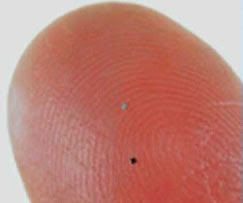Smart dust is a device which is as small as dust particles. It is a combination of lots of tiny microelectromechanical system, in short, it is stated as MEMS. Smart dust is made up of a small particle or speck which are tiny sensors that can perform a variety of functions which can detect light, temperature, vibration, magnetism, chemicals, and heat. It is generally operated wirelessly. They are distributed over some area to perform tasks usually such as sensing, this process is done through radio frequency identification. The range of tiny smart dust devices is measured in a few millimeters.

Sensor type finds out how these motes can be used for.
Some of the examples in the current use of this device are to check and help prevent forest fires erosion by chemical action in chemical factories and warning a local power & lighting company about any street light which is out of service and it needs work in it.
The biggest benefit of having a large network of nodes is that of the system of checking errors in measurements of one tiny device can be crossed check with its neighbors and even if a mote fails to work any others can work out with its function.
The concepts of Smart Dust come out into view from a workshop at RAND in 1992 and the series of DARPA ISAT studies in the mid-1990s .it came into view due to the capable applications of the technologies. The first public presentation on the concept was by the name at the American Vacuum Society .its meeting was held in 1996 at Anaheim.
A Smart Dust research offer was presented to DARPA. Which was written by
- Kristofer S J Pister
- Joe Kahn
- Bernhard Bose
They all three belong to the same college ”University of California” the idea to build wireless sensor device with a volume of few millimeter, was finalized, they started giving funds for the project in 1998.The project led to a working such as was smaller than a grain of rice.
The concept of smartdust was later increased in extent by Kris Pister in 2001.
Smart Dust is a large network of motes which are identical or similar tiny computers. They consist of four small-scale constructed components:
- Ambient sensor
- Wireless Transmitter such as wi-fi, Bluetooth etc.
- CPU
- Power Source such as batteries, solar cell, kinetic energy converter etc.
The sensor components together form a network where they can communicate with outsider source and each other.
The function of the ambient sensor is to record a certain parameter near the mote. The CPU deals with the measurements and then shares them over the network with both the server and all another close by motes. Many different ‘species’ of motes can work together in a huge cluster of networks; the function of one mote is to measure heat, other is to measure vibration and third is to pertain the expanse position of a certain element wherever it is located.
A group of Smart Dust motes are able to measure one or a lot of parameters of an environment and partially processes and transmits those measurements to a central computer.
The most and highly important are the performance ways and characteristics such as the
- Mote size
- Quality of a mote
- Price per tiny particles
- Sensor type
- Sensor quality
- Networking technology
- Quality of networking technologies
- Power sources which fix lifetime
Currently, the Smart Dust motes are comparatively large and expensive. Their ranges vary from sizes between a matchbox to a small coin. The motes are now relatively capable of getting hurt. In order to fulfill the Smart Dust, a smaller sensor should be designed those are capable of hard-wearing, a pressure resister, moisture, and a temperature changer etc.
There are lots of different ways that how motes might be used, and as people get familiar with the new concept they come up with even more and work more on it. Sensor motes are now used as the latest technology and as the most effective ones.
- The core of a mote is small, low costing and a low power computer
- The computer can monitor one or more than one sensors.
- It is easy to assume all sorts of sensors including a temperature sensor, light, sound, position, vibration, stress, pressure, humidity sensors, etc.
Thank you for reading our article and if you have any doubts/queries/suggestions, please feel free to comment below. If you find this article useful and knowledgeable, please share it with your circle. You can even contact us privately through the contact form or through social networking sites like Facebook, Twitter, Google+ etc.